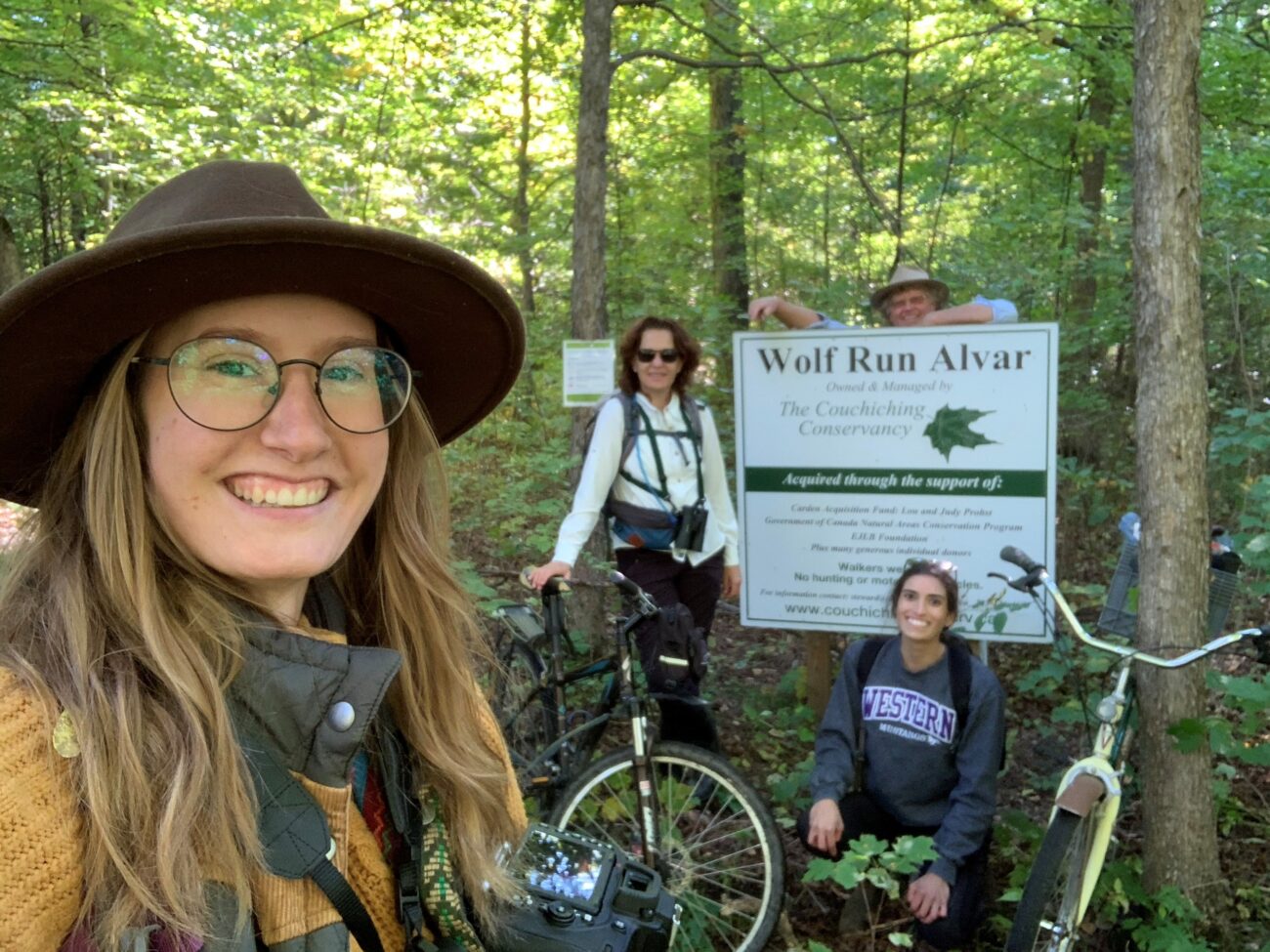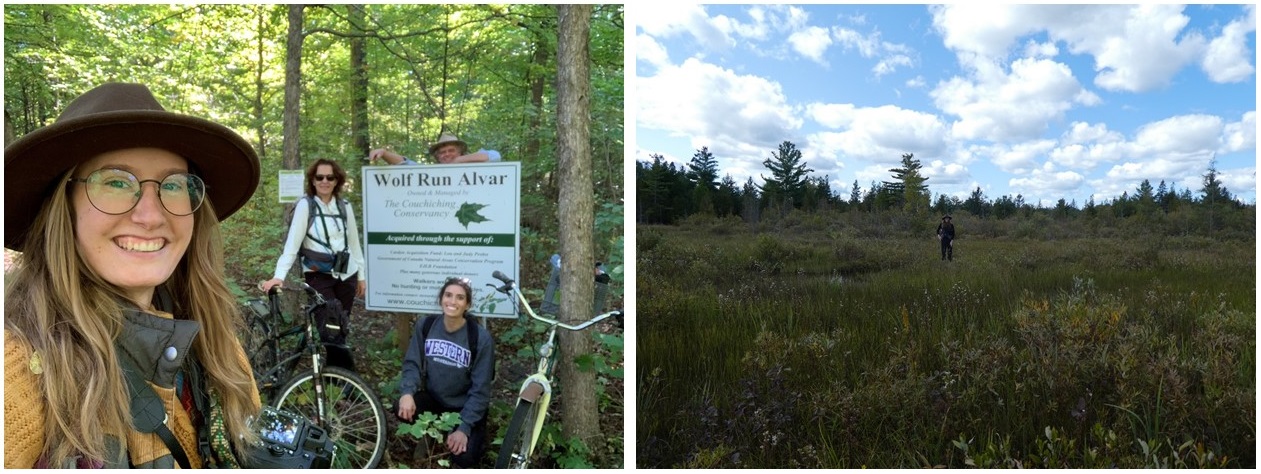
Wolf Run Alvar is a land-locked 303-acre nature reserve on the northern edge of Carden’s prime alvar habitat.
Because the property is so difficult to access, it has become an annual tradition for Tom Wilson (Carden Field Naturalists) to lead a fall tour. This year presented even more challenges than usual, since the already-rugged Wolf Run Lane washed out during an August rainstorm.
Undaunted, a group of 4 biked in Friday September 18th. It was a chance to document flora & fauna, listen to water flowing through the grykes, and enjoy one of the last sunny warm days of summer 2020. See more photos here.
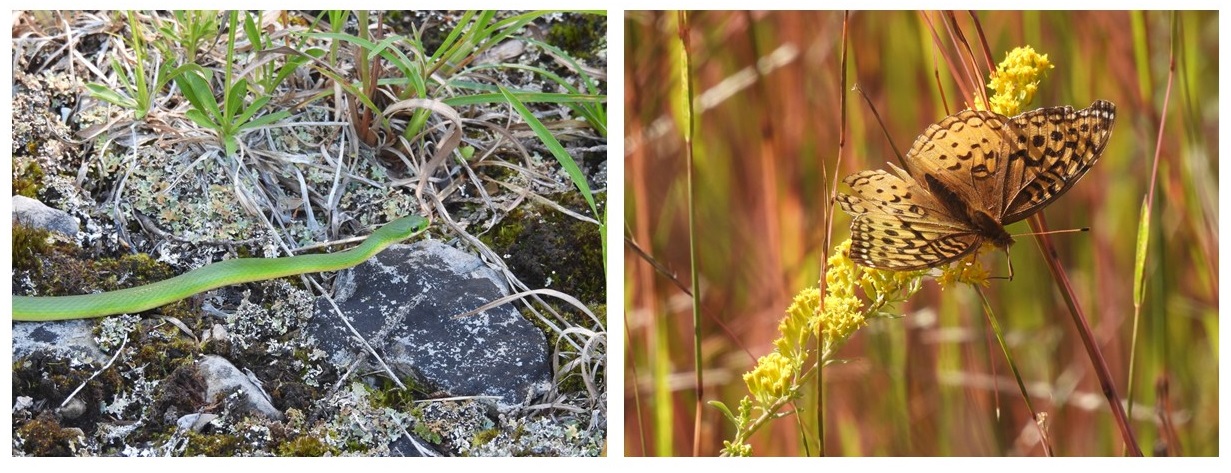
A Smooth Green Snake and (possibly) a Great Spangled Fritillary (photos: Tanya Clark)
Ron Reid and Tanya Clark ventured out to the Carden alvar on September 3 to scout out trails, flora, and fauna. They came across this Smooth Green Snake. While it glided away into the grasses, it was shaking its head back and forth. The behavior could be to blend into the vegetation or smelling what was nearby. They also saw high quality alvar species such as False Penny Royal and Little Bluestem.
“I do not love snakes, but this one was kind of cute. From a distance. As I’m walking away,” said Tanya.
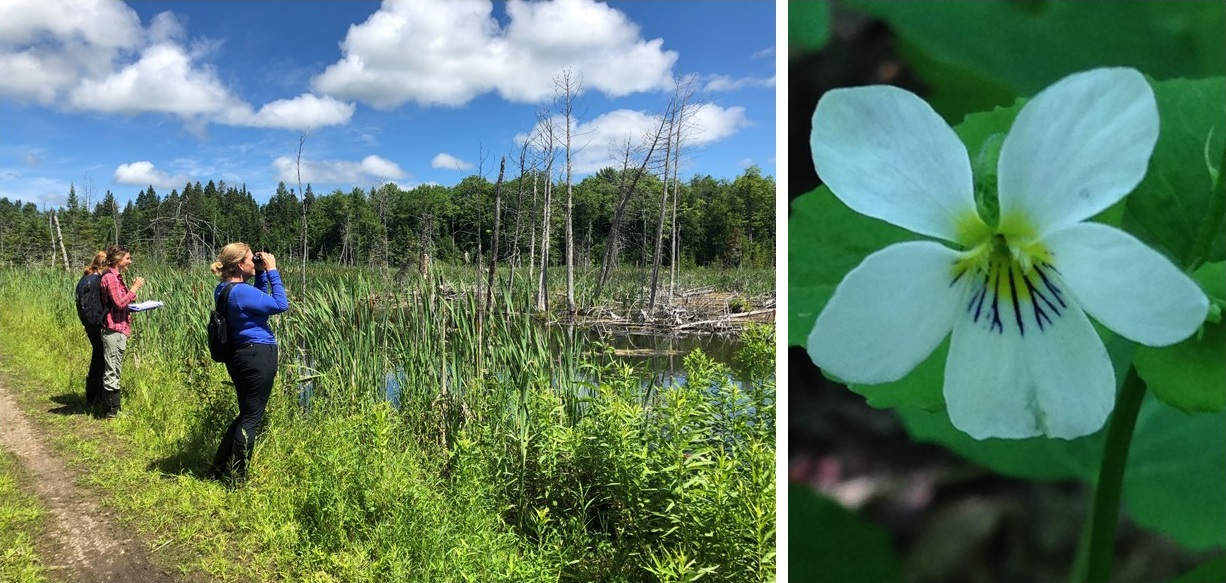
Taylor Pierce, Shelley Pierce, Monica Gallant, and a Viola canadensis. photos: Toby Rowland and Nancy Chong.
New Volunteer Alert! We continue to partner with Copeland Forest Friends on Citizen Science projects, and this summer added a reptile monitoring team and a plant monitoring team. Shelley & Taylor Pierce and Monica Gallant made their first Reptile Monitoring visit in July, and delivered some interesting observations.
Meanwhile, Nancy Chong and Ruth Henderson have taken on Plant Monitoring in an area of Copeland known for its high plant diversity.
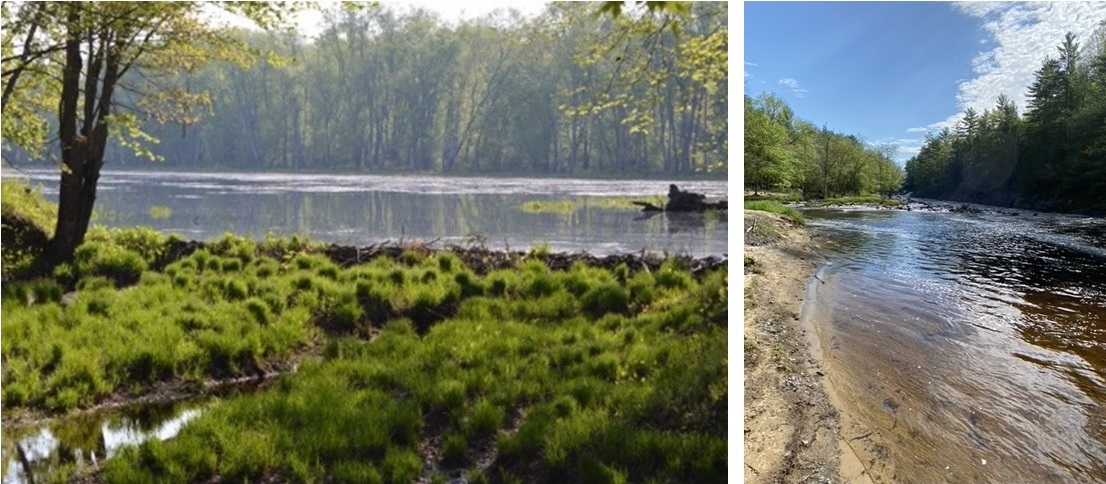
Photos: Mel Tuck
The Ron Reid Nature Reserve is 730 acres in the heart of QEII Wildlands Provincial Park. A visit to RRNR is a great way to start getting to know this area of our region.
A relatively new acquisition (December 2017), we’ve been able to establish several citizen science monitoring teams who keep an eye on the reptiles, amphibians, and bats who call the area home.
We also have two Land Stewardship Teams to watch out for human incursions and caretake the trail.
Thanks to Mel and Al Tuck, Ron Reid & Janet Grand, Nicole Ranville & Charleyne Hall, Larry Hrivnak & Tricia Currie, Lindsay Cass & Evelyn McCloy. It takes a village.

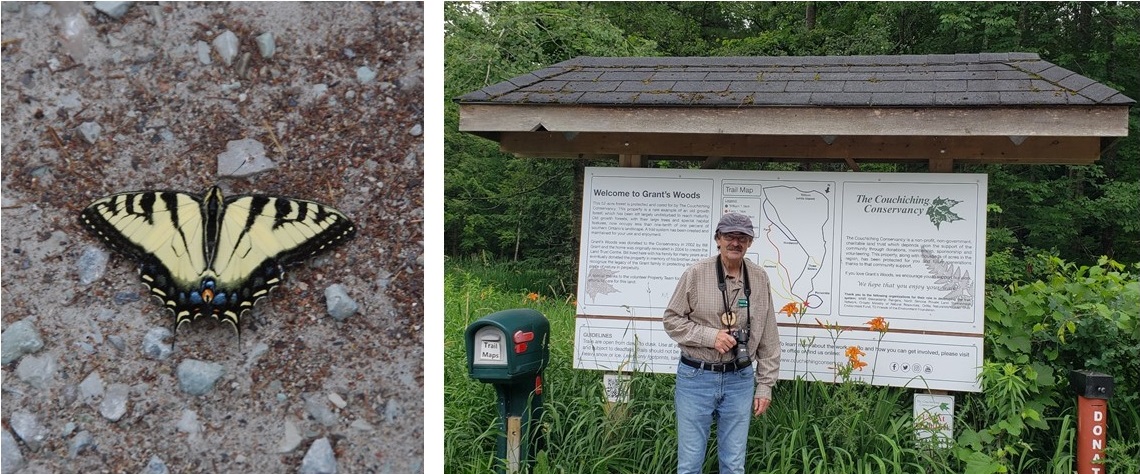
David Cowl is a multi-talented volunteer, contributing to several citizen science monitoring programs and serving as a Couchiching Conservancy ambassador.
On Saturday July 11th, David spent some time at Grant’s Woods, helping to educate trail users about our work. He also spotted this Swallowtail “puddling” in the parking lot:
“This Tiger Swallowtail butterfly is puddling, a behavior many butterfly species (and some moths) engage in. Puddling sites can include wet soil, mud, fermenting fruit, dung and carrion. The key is the chemical makeup of the site as these butterflies are looking for salts, minerals and amino acids to enhance reproduction. For nature enthusiasts, puddling behavior is a great way to capture butterfly photos.”
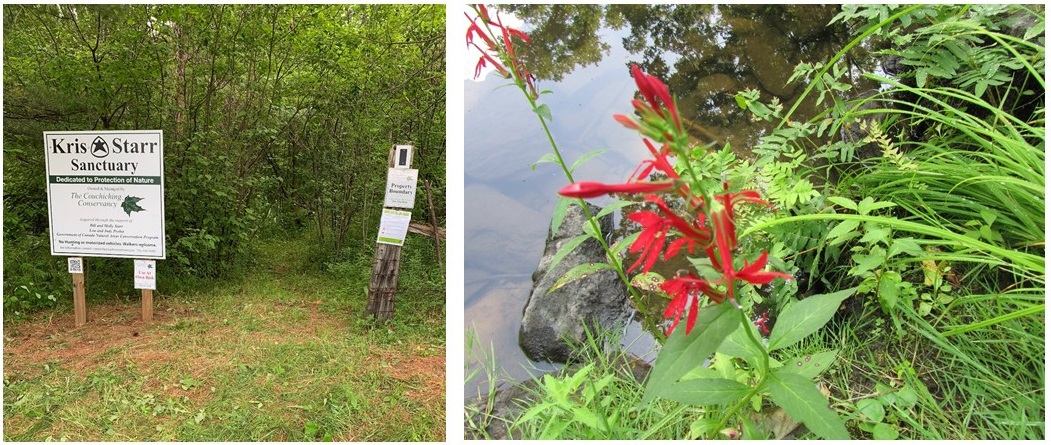
The repaired sign at Kris Starr (photo: Alan Smale) and Cardinal Flower in bloom along the banks of the Head River (photo: Gerry Church)
Thanks to Alan Smale and Mike for taking on a much needed repair of the Kris Starr Sanctuary property sign. It looks great!
The Kris Starr Sanctuary was a partial purchase/partial donation by Bill and Molly Starr in memory of their son Kris Starr. It is located on both sides of the Monck Road near Turner Road and has walking trails open to the public. Park on Turner Road.

Dave repairing the water line on Turnbull Ranch. Photo: Brittany Hope, NCC
Dave’s “Stewardship ain’t no desk job” series continues: While conducting the Dog Strangling Vine control program at Turnbull Ranch Nature Reserve a call came in from Wildlife Preservation Canada that water had stopped flowing to their research cabin, located on the property.
Setting spray backpacks aside, Dave Hawke (Couchiching Conservancy) and Brittany Hope (Nature Conservancy of Canada) swung into action, locating two leaks and repairing both with combined use of field repair knowledge and a tool set carried in the NCC vehicle. With the repairs successfully done, the cattle waiting nearby had no choice but to abandon their squishy fun in the mud.

Crescents and Swallowtails feed on the black bear’s regurgitation. Note the lonely skipper off side and blue bee in the foreground. Photos: David Hawke
Bears, Butterflies, and Blandings Turtles:
It’s that time of year when Dave joins staff from the Nature Conservancy of Canada (Brittany Hope this year) in working to control invasive Dog Strangling Vine on the Carden Alvar. Dave checked in to say they’d had an eventful day: “Rescued a wounded young Blanding’s turtle (thanks to the volunteers from Scales Nature Park and the Ontario Turtle Trauma Centre), saw a bear, and found Crescents and Swallowtails feeding on bear vomit.”
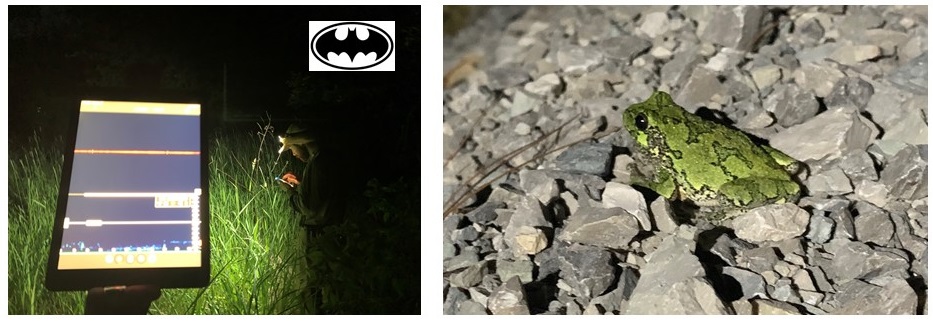
Photos: Joelle Burnie A Grey Tree Frog at Wilson’s Point Wetland
“The Bat Pad” made its debut the first week of Summer, with a visit to four different Nature Reserves to monitor for bats. This new bat monitoring equipment courtesy of the Angela Rehhorn Citizen Science Memorial Fund. Grey tree frogs can change colour in order to camouflage themselves. This one would have been better off sticking to grey!

